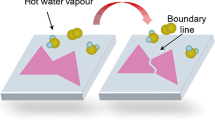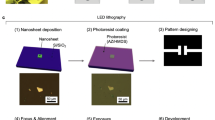Abstract
Transition metal dichalcogenides (TMDs) have been widely studied as attractive two-dimensional (2D) materials. In particular, specific TMD materials have attracted increasing attention because of their intriguing features as 2D topological insulators (TIs), which have a metallic edge state and bulk band gap. To realize next-generation devices that employ the metallic edge states of 2D TI materials, precise patterning of the edges is essential. In this study, we demonstrate a simple nanopatterning technique for 1 T’-MoTe2, which is known to be a 2D TI material, using atomic force microscopy (AFM)-based scanning probe lithography (SPL). Our AFM-based SPL method entails delicately scratching a few-layer 1 T’-MoTe2 sample while applying an electric field using a conductive AFM tip. The proposed method enables nanoscale lines, holes, and letters to be reliably patterned on the 1 T’-MoTe2 sample. This study results in the development of a clean method that is compatible with existing mass-production facilities to fabricate various TMD materials for realizing next-generation electronic devices and for studying the underlying physics of these materials.





Similar content being viewed by others
Data availability statement
The datasets generated during and/or analysed during the current study are available from the corresponding author on reasonable request.
References
S. Manzeli, D. Ovchinnikov, D. Pasquier, O.V. Yazyev, A. Kis, 2D transition metal dichalcogenides. Nat Rev Mater 2, 17033 (2017)
M. Zeng, Y. Xiao, J. Liu, K. Yang, L. Fu, Exploring two-dimensional materials toward the next-generation circuits: From monomer design to assembly control. Chem Rev 118, 6236 (2018)
T. Chowdhury, E.C. Sadler, T.J. Kempa, Progress and prospects in transition-metal dichalcogenide research beyond 2D. Chem Rev 120, 12563 (2020)
K. Khan, A.K. Tareen, M. Aslam, R. Wang, Y. Zhang, A. Mahmood, Z. Ouyang, H. Zhang, Z. Guo, Recent developments in emerging two-dimensional materials and their applications. J Mater Chem C 8, 387 (2020)
M.Z. Hasan, C.L. Kane, Colloquium: Topological insulators. Rev Mod Phys 82, 3045 (2010)
Y. Xia et al., Observation of a large-gap topological-insulator class with a single Dirac cone on the surface. Nat Phys 5, 398 (2009)
B.A. Bernevig, T.L. Hughes, S.C. Zhang, Quantum spin Hall effect and topological phase transition in HgTe quantum wells. Science 314, 1757 (2006)
C.L. Kane, E.J. Mele, Quantum spin Hall effect in graphene. Phys Rev Lett 95, 226801 (2005)
M. König, S. Wiedmann, C. Brüne, A. Roth, H. Buhmann, L.W. Molenkamp, X.L. Qi, S.C. Zhang, Quantum spin Hall insulator state in HgTe quantum wells. Science 318, 766 (2007)
L. Fu, C.L. Kane, E.J. Mele, Topological insulators in three dimensions. Phys Rev Lett 98, 106803 (2007)
S. Cai et al., Independence of topological surface state and bulk conductance in three-dimensional topological insulators. NPJ Quantum Mater. 3, 62 (2018)
M.V. Bollinger, J.V. Lauritsen, K.W. Jacobsen, J.K. Nørskov, S. Helveg, F. Besenbacher, One-dimensional metallic edge states in MoS2. Phys Rev Lett 87, 196803 (2001)
C. Pauly et al., Subnanometre-wide electron channels protected by topology. Nat Phys 11, 338 (2015)
L. Peng, Y. Yuan, G. Li, X. Yang, J.J. Xian, C.J. Yi, Y.G. Shi, Y.S. Fu, Observation of topological states residing at step edges of WTe2. Nat Commun 8, 659 (2017)
H.W. Kim et al., Symmetry dictated grain boundary state in a two-dimensional topological insulator. Nano Lett. 20, 5837 (2020)
S.C. Minne, Ph. Flueckiger, H.T. Soh, C.F. Quate, Atomic force microscope lithography using amorphous silicon as a resist and advances in parallel operation. J Vac Sci Technol B 13, 1380 (1995)
R. García, M. Calleja, F. Pérez-Murano, Local oxidation of silicon surfaces by dynamic force microscopy: Nanofabrication and water bridge formation. Appl Phys Lett. 72, 2295 (1998)
R. Garcia, R.V. Martinez, J. Martinez, Nano-chemistry and scanning probe nanolithographies. Chem Soc Rev 35, 29 (2006)
L. Weng, L. Zhang, Y.P. Chen, L.P. Rokhinson, Atomic force microscope local oxidation nanolithography of graphene. Appl Phys Lett 93, 093107 (2008)
S. Masubuchi, M. Ono, K. Yoshida, K. Hirakawa, T. Machida, Fabrication of graphene nanoribbon by local anodic oxidation lithography using atomic force microscope. Appl Phys Lett 94, 082107 (2009)
M. Donarelli, F. Perrozzi, F. Bisti, F. Paparella, V. Feyer, A. Ponzoni, M. Gonchigsuren, L. Ottaviano, Few layered MoS2 lithography with an AFM tip: Description of the technique and nanospectroscopy investigations. Nanoscale 7, 11453 (2015)
A.I. Dago, Y.K. Ryu, R. Garcia, Sub-20nm patterning of thin layer WSe2 by scanning probe lithography. Appl Phys Lett 109, 163103 (2016)
P. Zhao, R. Wang, D.H. Lien, Y. Zhao, H. Kim, J. Cho, G.H. Ahn, A. Javey, Scanning probe lithography patterning of monolayer semiconductors and application in quantifying edge recombination. Adv Mater 31, e1900136 (2019)
Y. He, H. Dong, T. Li, C. Wang, W. Shao, Y. Zhang, L. Jiang, W. Hu, Graphene and graphene oxide nanogap electrodes fabricated by atomic force microscopy nanolithography. Appl Phys Lett 97, 133301 (2010)
B. Vasić, M. Kratzer, A. Matković, A. Nevosad, U. Ralević, D. Jovanović, C. Ganser, C. Teichert, R. Gajić, Atomic force microscopy based manipulation of graphene using dynamic plowing lithography. Nanotechnology 24, 015303 (2013)
P. Kun, B. Fülöp, G. Dobrik, P. Nemes-Incze, I.E. Lukács, S. Csonka, C. Hwang, L. Tapasztó, Robust quantum point contact operation of narrow graphene constrictions patterned by AFM cleavage lithography. NPJ 2D Mater Appl 4, 43 (2020)
Y.M. Kim, J. Lee, D.J. Jeon, S.E. Oh, J.S. Yeo, Advanced atomic force microscopy-based techniques for nanoscale characterization of switching devices for emerging neuromorphic applications. Appl Microsc 51, 7 (2021)
M. Moreno-Moreno, P. Ares, C. Moreno, F. Zamora, C. Gómez-Navarro, J. Gómez-Herrero, AFM manipulation of gold nanowires to build electrical circuits. Nano Lett 19, 5459 (2019)
M. Kim, S. Lee, J. Lee, D.K. Kim, Y.J. Hwang, G. Lee, G.R. Yi, Y.J. Song, Deterministic assembly of metamolecules by atomic force microscope-enabled manipulation of ultra-smooth, super-spherical gold nanoparticles. Opt Express 23, 12766 (2015)
J.B. Park, B. Jaeckel, B.A. Parkinson, Fabrication and investigation of nanostructures on transition metal dichalcogenide surfaces using a scanning tunneling microscope. Langmuir 22, 5334 (2006)
Acknowledgements
This work was supported by the National Research Foundation of Korea (NRF) grant funded by the Korea government (MSIT) (Grant No. 2020R1A2C1005299).
Author information
Authors and Affiliations
Corresponding authors
Additional information
Publisher's Note
Springer Nature remains neutral with regard to jurisdictional claims in published maps and institutional affiliations.
Rights and permissions
Springer Nature or its licensor (e.g. a society or other partner) holds exclusive rights to this article under a publishing agreement with the author(s) or other rightsholder(s); author self-archiving of the accepted manuscript version of this article is solely governed by the terms of such publishing agreement and applicable law.
About this article
Cite this article
Gu, M.S., Ku, J., Jang, WJ. et al. Electric field-assisted patterning of few-layer MoTe2 by scanning probe lithography. J. Korean Phys. Soc. 82, 274–279 (2023). https://doi.org/10.1007/s40042-022-00673-x
Received:
Revised:
Accepted:
Published:
Issue Date:
DOI: https://doi.org/10.1007/s40042-022-00673-x




